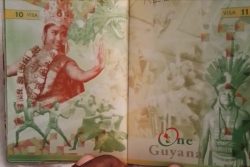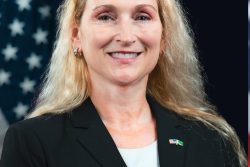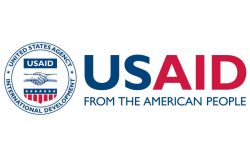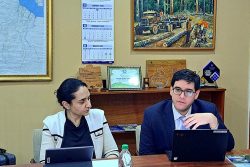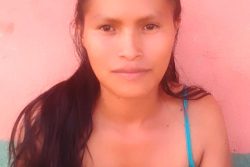Some of the Indigenous nations have been in contact with Europeans and later coastal society for hundreds of years. In the sixteenth century the Arawaks, for example, used to travel by boat to the infertile pearl island of Cubagua to supply the Spaniards with cassava and other items, and on at least one occasion saved the inhabitants from starvation. When the Dutch occupied Essequibo and Berbice in the seventeenth century, nations such as the Caribs, the Akawaios and the Warraus in addition to the Arawaks, also kept the colonists alive with food supplies initially, later going on to trade a wide variety of items with them. In that century too they supplied a commodity which was marketed in Amsterdam and was second only in importance to sugar as an export. This was annatto which was used to colour Dutch cheeses.
The point was that in the days when colonist numbers were small and even when combined with the totals for their enslaved people they did not exceed Indigenous population figures, those members of nations who were not living cheek by jowl with the plantations could to a large extent set their own terms for the contact. The Dutch were not interested in converting anyone, and apart from the posts they set up in some of the rivers, their forays into the interior tended to be connected to trade. As such, they struck alliances with certain nations, the most significant one being with the Caribs of Essequibo who are partly responsible for Guyana’s western border having the contours it does today.
The Caribs, the geopoliticians of the region, were unrelievedly hostile to the Spaniards, and had been so ever since Alonso de Herrera first sailed up the Orinoco in 1534. They considered their alliance with the Dutch essential for their own survival and independence, because that way they could secure firearms and learn the battle tactics associated with these at a time when repeating rifles were yet to be invented.
The Caribs recognised that the instrument of Spanish penetration in the region was the Capuchin missions which they did not hesitate to raid, and although it upset Governor Storm van’s Gravesande of Essequibo to see them with items clearly taken from churches, he never tried to stop them since they were effectively performing border duty. As it was, the nearest any mission ever came to our Guyana was Tumeremo, safely on the other side of the Cuyuni in what is currently Venezuelan territory. It is this settlement, now a mining town, which President Nicolàs Maduro has had the effrontery to name the capital of what he calls ‘Guyana Esequiba’.
With the demographic shift which began to become evident at the end of the Dutch period and accelerated dramatically under the British in the nineteenth century, the basis of the relationship between the colonizers and the coastal inhabitants on the one hand, and the Indigenous nations on the other changed. The Indigenous were no longer needed for trading purposes or for work at the posts and on the plantations, and they were not in a position to control the intrusions into their world inflicted by loggers and eventually miners, or even the far more benign missionaries. As a consequence diseases like measles, influenza and smallpox took their toll.
Beginning with an act in 1902 which was expanded in 1910, the British decided to isolate the Indigenous population from the coastal one with the creation of reservations. It was a paternalistic approach, since the Indigenous had no control over the administration of their reservations or ownership of the land; the intention simply was to protect them from the depredations of coastlanders, especially miners. In the 1950s there was an advance in the form of the recognition of villages, districts and areas which allowed for the evolution of a very limited measure of local government.
But the first major political awakening of the Indigenous people in modern times came with the work of Stephen Campbell, the first Indigenous member of Parliament who campaigned for land rights, which were given recognition in an annexe to the Constitution Agreement, and made possible the setting up of the Amerindian Lands Commission. The first land titles were issued in 1976, with more subsequently, but little change to local government arrangements. Then came the 2006 Act, which has come under considerable criticism and which this government has undertaken to amend or replace.
Under the Act the appointment of councillors to villages is via elections, the number of which depends on the size of the village or district. There is no ancient tradition of government in a formal sense among the Indigenous, and no chiefs in any tribal sense; their communities were more or less acephalous. The Dutch did recognise captains, investing them with insignia, but these were just individuals who were chosen to distribute so called ‘presents’, which were really payments for services rendered. They were referred to as ‘Captains’ by both the Dutch and the British. The Caribs had leaders only for war purposes, and these the Dutch called ‘Uils’ (Owls in English), clearly the nearest rendering the Dutch could manage of a Carib term.
Nowadays the leaders of villages have been designated ‘Toshaos’, a word brought into this country by the Wapichan and Macushis after they broke out of the Portuguese missions in the Rio Branco and took refuge here. It is a lingua geral term and may be of Tupi extraction. Toshaos are also elected.
But the 2006 Act did something else, and that is create District Councils which can be formed of three of more village councils to look at matters of common interest, and a National Toshaos Council which meets about once every two years. Since the ruling party is dependent on the Amerindian vote to achieve a majority, the Toshaos Council would seem to offer a convenient route for keeping the Indigenous population onside. Certainly the party attempted to manage the 2022 meeting by controlling the agenda, among other things, although in the end it was forced to back down, at least partially.
Both our major parties have tended to see Amerindians mostly in the light of potential electors, and have attempted to buy their vote when in office with a flurry of outboard engines, village roads where appropriate, and the like, in a kind of colonial ‘presents’ tradition. But there are signs that the population is beginning to explore politically and assert itself. Even after the passage of the 2006 Act, Amerindians still remained largely cut off from the realities of coastal politics, but nowadays they are in far more direct contact with the coast, and electronic devices along with television have penetrated the hinterland as much as elsewhere.
Furthermore, they are now aware of international organizations to whom they can apply when they are suffering at the hands of miners in particular. Chinese Landing, for example, appealed to the Inter-American Commission on Human Rights, which issued precautionary measures in their favour. The government, however, has asked for these to be withdrawn because they claimed they were based on a misrepresentation. In the end, with the gold price so high the government favours the miners over Indigenous villagers in disputes, but with greater sensitisation among the communities about the avenues for complaint, the administration may find that its traditional tactics of ignoring their concerns has its limits.
An evolving assertion of autonomy was apparent too from a report last week on a meeting of the Upper Mazaruni District Council, comprising eight villages of the Akawaio and Arecuna nations. In addition to the problems they faced as a consequence of the current drought, they discussed environmental issues arising from mining and the violation of their land rights especially by miners encroaching on sacred sites. Among the ten issues too was one related to the Guyana-Venezuela border and most significantly, the need for a transparent National Toshaos election process, free from political interference.
The Council noted, “These deliberations underscored the gravity of the challenges facing the Upper Mazaruni District and highlighted the collective determination to address them effectively.” It can only be hoped that the government will respect this demonstration of independent action, and move to a position where it will recognise the right of the Indigenous population to be free to make their own decisions without interference from national political entities.
In a recent letter to this newspaper Mr Medino Abraham suggested that as the Toshao election season approaches, candidates should engage in debates so villagers can hear their plans for the development of their communities. It might be observed that apart from anything else this would appear to be a good way of cultivating meaningful political participation among villagers, who will listen to the different proposals and then make up their minds.
Our politicians should start to take notice: Indigenous people are beginning to make their own political resolutions without reference to them.

